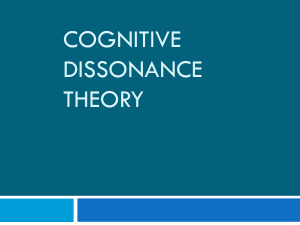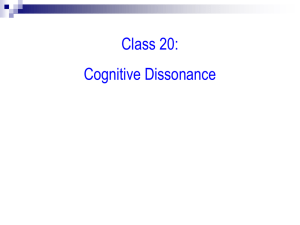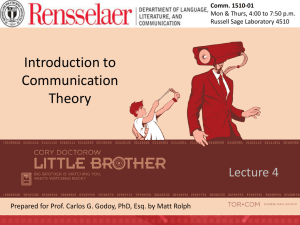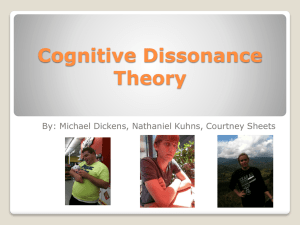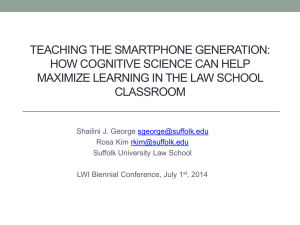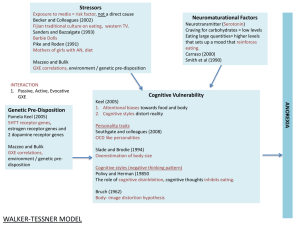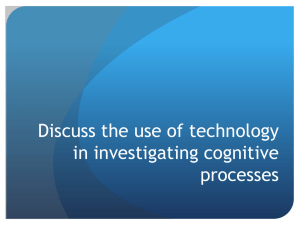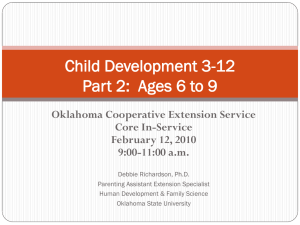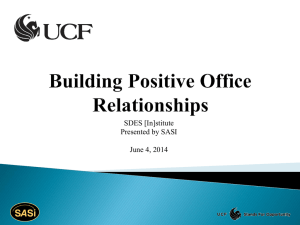lecture10
advertisement
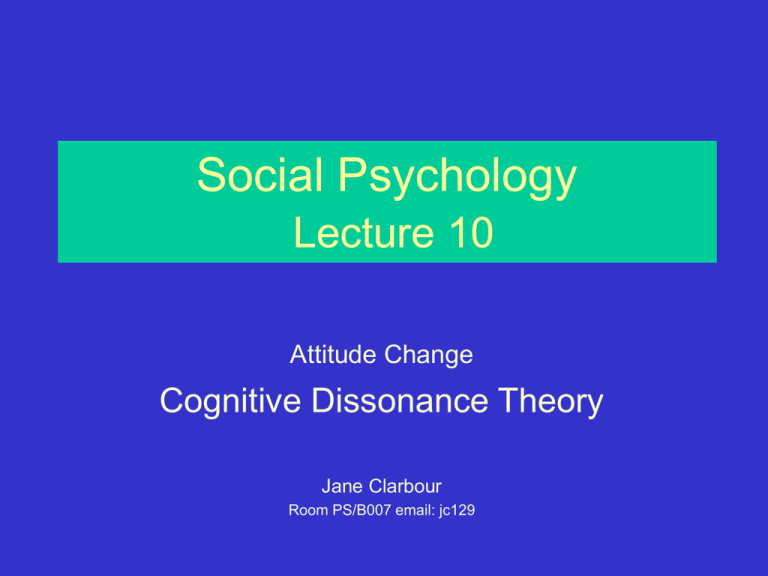
Social Psychology Lecture 10 Attitude Change Cognitive Dissonance Theory Jane Clarbour Room PS/B007 email: jc129 Objectives • Define ‘cognitive dissonance’ • Report an experiment on how cognitive dissonance can occur in decision making • Explain the ‘forced compliance’ paradigm • Account for the role of arousal in cognitive dissonance theory • State revisions to cognitive dissonance theory • Demonstrate an understanding of how cognitive dissonance can be reduced. Cognitive Dissonance Theory • Festinger (1957) – Cognitive dissonance occurs when there is inconsistency between 2 cognitions • Cognitions: knowledge, opinions, beliefs (relating to self, behaviour, or environment) • Dissonance: A state of psychological tension which motivates people to do something to get rid of it to resume cognitive consistency Example of cognitive dissonance • Smoker – Knowledge that wants a cigarette – Knowledge that smoking causes cancer Desire Knowledge Wants to stop smoking Smoking is bad for health Creates state of tension Motivated to get rid of discomfort! Festinger’s main ways to reduce dissonance: • Change behaviour • Change cognitions (focus of most research) • Add new information Cognitive dissonance in decision making • Dissonance occurs due to continued attraction towards rejected alternative – Reduction of dissonance by: 1. Viewing chosen alternative A more positively 2. Viewing rejected alternative B more negatively 3. Attitude changed as a result of making the decision Decision making study • Ss in the experimental choice condition rated their chosen article (A) as more attractive than in their first rating. • Rejected article (B) rates as less attractive Choice No choice Time 1 A6/B6 A6 Time 2 A7/B5 A6 No change in control Decision making experiment: Early conclusions (Brehm, 1956) • Supports the predictions of cognitive dissonance theory – Attitude change is a consequence of having to make the decision Forced compliance paradigm • Forced compliance may involve either/both of two elements: 1. counter-motivational • Performing behaviours don’t want to 2. counter-attitudinal • Stating like things when don’t really like them Justification for attitude change • Cognitive dissonance theory – small rewards are most likely to affect attitude change by making the attitude to the product more favourable. – The smaller the reward, the greater the dissonance Boring tasks experiments Festinger & Carlsmith (1959) • Forced compliance paradigm – Wooden peg task – Spools of thread task • Ss have to tell next Ss that task was really interesting (3 conditions) C1: paid $1 C2: paid $20 C3: Control (not paid at all) Results Festinger & Carlsmith (1959) Level of interest in task Wooden pegs Threads $1 $20 control The role of arousal in CDT (Cooper et al, 1978) • Arousal is hypothesised to motivate attitude change – Ss were asked to write an essay justifying the pardon of ex-president Nixon – Experimental Ss given pills and placed into various conditions to manipulate arousal • Tranquillizer (‘downer’) • Amphetamine (‘upper’) • Placebo (milk power) Design of arousal and forced compliance experiment • 2 x 3 factorial design – Choice: 2 levels • (High choice/low choice) – High choice: up to Ss if want to take part – Low choice: just given paper to write on – Arousal: 3 levels • Phenobarbital (tranquilliser condition) • Amphetamine (arousal condition) • Milk power (placebo condition) Results • Placebo – Sig. more attitude change in the direction of the essay for high choice than low choice • Tranquilliser condition – No difference when compared to control group • Amphetamine – Attitude change increased in both high and low choice conditions • Shows arousal influences attitude change over and above cognitive appraisal (effect of choice) Findings so far… • Cognitive dissonance caused by inconsistency in beliefs • Attitude change as consequence of dissonance resolution • Attitude change must be own choice – (preference for goods decision making experiment: Brehm, 1956) . • The smaller the reward, the greater the dissonance – (interest in boring task experiment: Festinger & Carlsmith, 1959) • Arousal is necessary for attitude change (Cooper et al, 1978) http://chiron.valdosta.edu/mawhatley/ 767/cogdiss.htm Alternative interpretations of findings in forced compliance studies… • $20 fee too large (bribe) • Preservation of self-concept (not inconsistency of beliefs) (Aronson, 1968) • Attitude change reaffirms values (Steele & Liu, 1981) – But only necessary if feel responsible for choice/behaviour Commitment and volition (Brehm & Cohen, 1962) • Inconsistency between beliefs is insufficient to create cognitive dissonance – The subject must feel able to choose whether to perform the counter-attitudinal behaviour • Commitment and volition are necessary for cognitive dissonance – Feeling of responsibility – Control – Choice Revisions to cognitive dissonance theory • New Look theory (Cooper & Fazio, 1984) – Dissonance more to do with unwanted consequence, than inconsistent belief – Suggests greater emphasis on personal responsibility – Supports claims that arousal is motivational in attitude change in forced compliance tasks Revisions to cognitive dissonance theory • Radical dissonance theory (Beauvois & Joules, 1996) – greater focus on personal commitment – Stresses the importance of rationalisation of counter-attitudinal behaviour • Cognitive rationalisation • Act rationalisation In conclusion • Research suggests dissonance may be reduced two main ways: 1. Cognitive – – Getting rid of incongruence in beliefs Attribute responsibility to external source 2. Behavioural – – Change behaviour Rationalization of changed behaviour – – Cognitive rationalization Act rationalization Objective 1 • Define ‘cognitive dissonance’ – Festinger’s (1957) cognitive dissonance theory definition : • A state of psychological tension arising from inconsistency between two cognitions which motivates (drives) attitude change – Radical dissonance theory’s definition: • A process of cognitive or behavioural rationalization to reduce tension created by counter-attitudinal behaviour Objective 2 • Report an experiment on how cognitive dissonance can occur in decision making – Consumer research study showed that Ss reduced their ratings of objects they had previously highly rated when told they could only keep one of them (Brehm, 1956) Objective 3 • Define ‘forced compliance’ – When people act in a way which is problematic to them because it goes against their own beliefs • Note: Beauvois & Joule (1996) suggest that this paradigm works because it involves obedience to an authority figure Objective 4 • Account for the role of arousal in cognitive dissonance theory – Arousal is thought to motivate attitude change • Experimental examples include Cooper et al, (1978) – Tutorial 3 • Interpretation that necessary for change (Cooper & Fazio, 1984) • Discussion of lower rates of attitudinal change with external attribution for compliance Objective 5 • State revisions to cognitive dissonance theory – Radical dissonance theory (Beavois & Jules, 1996): • Emphasis on commitment • Stresses the importance of rationalisation of counterattitudinal behaviour – ‘New look’ approach (Cooper & Fazio, 1984) • Emphasis on personal responsibility Objective 6 • Demonstrate an understanding of how cognitive dissonance can be reduced. – Attribute responsibility to external source – Reduce the importance of dissonant cognitions – Add new cognitions that are similar to dissonant cognitions… Key reading • Beauvois & Joules (1996) Radical dissonance theory • Cooper & Fazio (1984) New look approach • Franzoi (2000) pp. 170 - 181

